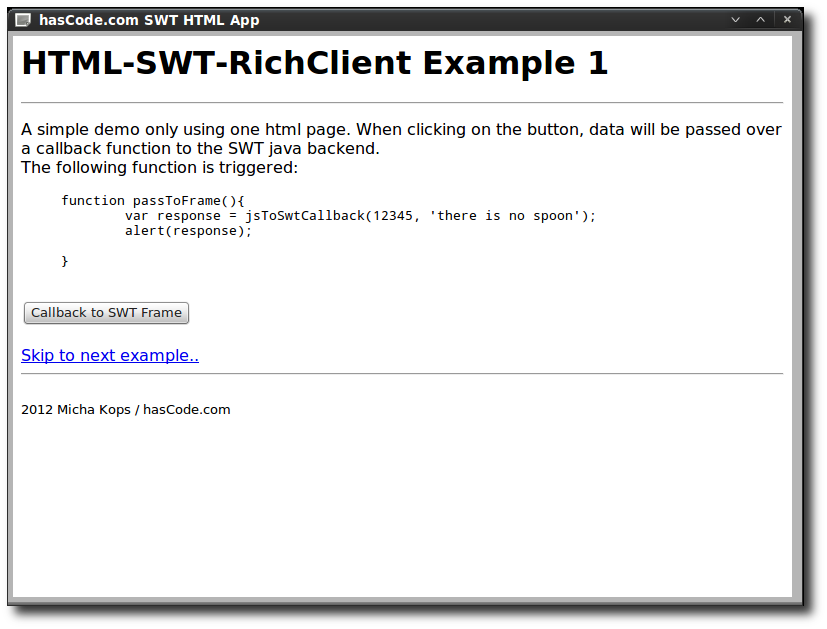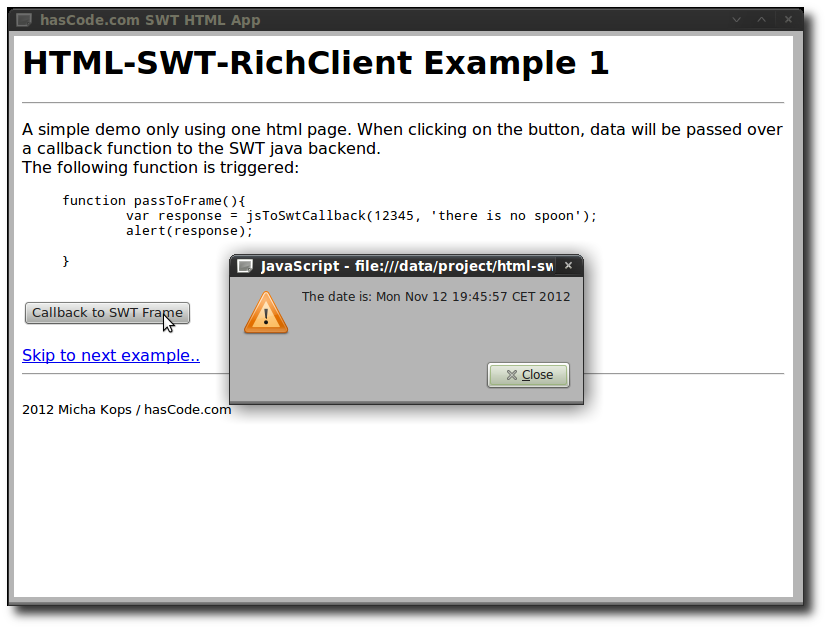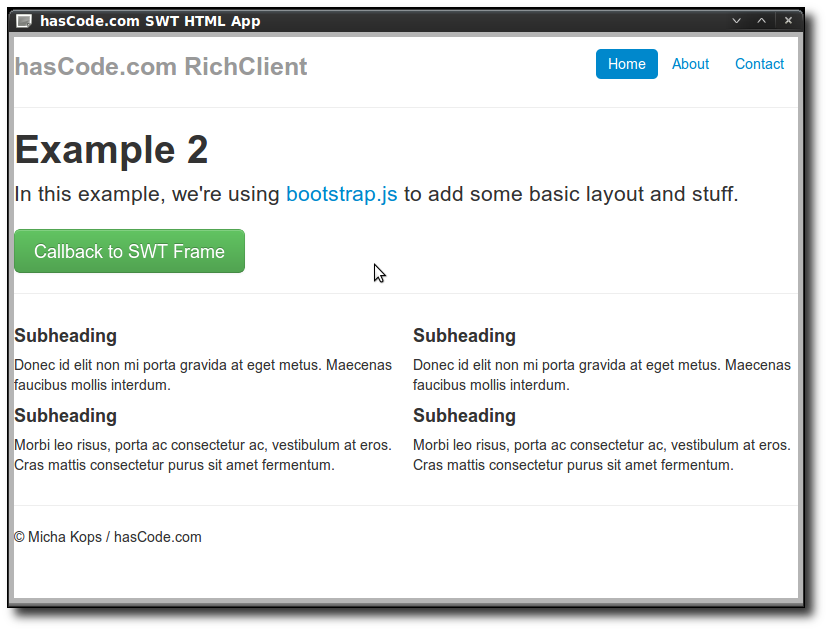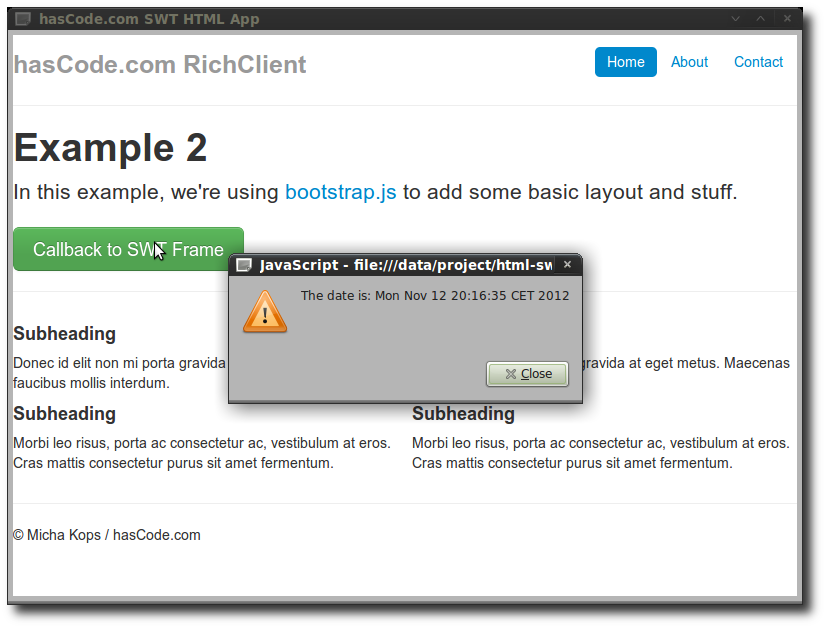Creating an offline Rich-Client-Application using HTML, CSS and Java with SWT
November 12th, 2012 by Micha KopsThere are a lot of frameworks out there to create offline applications and rich clients in Java.
One exotic alternative is to use the HTML, CSS and Javascript for this purpose and render the application in a Java frame using SWT and SWT’s browser component.
Contents
Creating a new Project
We’re using maven here for our project but you shouldn’t have a problem to use SBT, Gradle or Ivy instead…
Adding Maven Dependencies
We need two things .. first comes a repository for the swt dependencies …
<repositories> <repository> <id>swt-maven-repo</id> <url>https://swt-repo.googlecode.com/svn/repo/</url> </repository> </repositories>
Second we need one platform dependency for swt ..
<dependencies> <dependency> <groupId>org.eclipse.swt</groupId> <artifactId>${swt.os.type}</artifactId> <version>3.8</version> </dependency> </dependencies>
We’ll be setting the artifactId in the next step..
Supporting different Operating Systems
Different dependencies for the different operation systems and bit variants … I am using maven profiles here to handle this .. by adding a parameter -PprofileId you may select your appropriate system.
I am using a 64bit linux OS, that’s why I have enabled the corresponding profile as default profile by setting activeByDefault to true.
<profiles> <profile> <id>linux_32</id> <activation> <os> <name>linux_x32</name> </os> </activation> <properties> <swt.os.type>org.eclipse.swt.gtk.linux.x86</swt.os.type> </properties> </profile> <profile> <id>linux_64</id> <activation> <os> <name>linux</name> </os> <activeByDefault>true</activeByDefault> </activation> <properties> <swt.os.type>org.eclipse.swt.gtk.linux.x86_64</swt.os.type> </properties> </profile> <profile> <id>mac_64</id> <activation> <os> <name>mac os x 64</name> </os> </activation> <properties> <swt.os.type>org.eclipse.swt.cocoa.macosx.x86_64</swt.os.type> <platformVmArgs>-XstartOnFirstThread</platformVmArgs> </properties> </profile> <profile> <id>windows_32</id> <activation> <os> <family>windows</family> </os> </activation> <properties> <swt.os.type>org.eclipse.swt.win32.win32.x86</swt.os.type> </properties> </profile> <profile> <id>windows_64</id> <activation> <os> <family>windows_x64</family> </os> </activation> <properties> <swt.os.type>org.eclipse.swt.win32.win32.x86_64</swt.os.type> </properties> </profile> </profiles>
Building the SWT Frame Application
We’re building a simple swt frame application here and use swt’s browser element to render our application.
Important here is the BrowserFunction in line 45 .. this adds a Javascript function to the scope of the HTML “app” named jsToSwtCallback.
This function logs alle parameters passed to from the html page to the java swt frame application and returns a string back to the javascript with the current date.
This is my application:
package com.hascode.app; import java.io.File; import java.util.Date; import org.eclipse.swt.SWT; import org.eclipse.swt.browser.Browser; import org.eclipse.swt.browser.BrowserFunction; import org.eclipse.swt.layout.GridData; import org.eclipse.swt.layout.GridLayout; import org.eclipse.swt.widgets.Display; import org.eclipse.swt.widgets.Shell; public class RichClient { private static final int APP_HEIGHT = 600; private static final int APP_WIDTH = 800; private static final String APP_TITLE = "hasCode.com SWT HTML App"; private static final File HTML_FILE = new File("app/main.html"); private Shell shell; private Display display; private Browser browser; private GridData browserLayout; public static void main(final String... args) { new RichClient().initializeApplication(); } public void initializeApplication() { display = new Display(); shell = new Shell(display); shell.setText(APP_TITLE); shell.setSize(APP_WIDTH, APP_HEIGHT); shell.setLayout(new GridLayout()); browser = new Browser(shell, SWT.NONE); browserLayout = new GridData(GridData.FILL_BOTH); browserLayout.grabExcessHorizontalSpace = true; browserLayout.grabExcessVerticalSpace = true; browser.setLayoutData(browserLayout); browser.setUrl(HTML_FILE.toURI().toString()); final BrowserFunction debugCallback = new CallbackDebugFunction( browser, "jsToSwtCallback"); System.out.println("browser initialized"); shell.open(); while (!shell.isDisposed()) { if (!display.readAndDispatch()) { display.sleep(); } } display.dispose(); } static class CallbackDebugFunction extends BrowserFunction { public CallbackDebugFunction(final Browser browser, final String name) { super(browser, name); } @Override public Object function(final Object[] arguments) { System.out.println("callback triggered by js function"); for (final Object o : arguments) { System.out.println("argument received: " + o.toString()); } return "The date is: " + new Date().toString(); } } }
HTML Layouts
Now that we’ve got our frame application we’re ready to create a simple layout. The only interesting thing here is the jsToSwtCallback javascript function .. this one is created by the frame application and allows to pass data betweend html scope and the java application.
First example: A simple layout
This is the code for our first, simple layout
<html>
<head>
<title>hasCode.com HTML-SWT-RichClient Example 1</title>
<script type="text/javascript">
function passToFrame(){
var response = jsToSwtCallback(12345, 'there is no spoon');
alert(response);
}
</script>
</head>
<body>
<h1>HTML-SWT-RichClient Example 1</h1>
<hr/>
<p>
A simple demo only using one html page. When clicking on the button, data will be passed over a callback function to the SWT java backend.
<br/>
The following function is triggered:<br/>
<blockquote><pre>
function passToFrame(){
var response = jsToSwtCallback(12345, 'there is no spoon');
alert(response);
}
</pre></blockquote>
</p>
<input type="button" value="Callback to SWT Frame" onclick="javascript:passToFrame()"/>
<br/>
<br/>
<a href="main-with-layout.html">Skip to next example..</a>
<hr/>
<br/>
<small>2012 Micha Kops / hasCode.com</small>
</body>
</html>Clicking the button should look like this
Second example: Using Bootstrap.js
In the next example we’re going to pimp our layout by using bootstrap.js – so we’re adding these libraries and the jQuery library to our app directory.
My directory structure now looks like this:
. ├── app │ ├── css │ │ ├── bootstrap.css │ │ ├── bootstrap.min.css │ │ ├── bootstrap-responsive.css │ │ └── bootstrap-responsive.min.css │ ├── img │ │ ├── glyphicons-halflings.png │ │ └── glyphicons-halflings-white.png │ ├── js │ │ ├── bootstrap.js │ │ ├── bootstrap.min.js │ │ └── jquery.min.js │ ├── main.html │ └── main-with-layout.html ├── pom.xml ├── README.md └── src ├── main │ ├── java │ │ └── com │ │ └── hascode │ │ └── app │ │ └── RichClient.java │ └── resources └── test ├── java └── resources 14 directories, 14 files
And this is my new template – I’ve take and modified an example from the bootstrap.js homepage here
<!DOCTYPE html>
<html>
<head>
<title>hasCode.com HTML-SWT-RichClient Example 2</title>
<link href="css/bootstrap.min.css" rel="stylesheet" media="screen">
</head>
<body>
<div>
<div>
<ul>
<li><a href="#">Home</a></li>
<li><a href="#">About</a></li>
<li><a href="#">Contact</a></li>
</ul>
<h3>hasCode.com RichClient</h3>
</div>
<hr />
<div>
<h1>Example 2</h1>
<p>
In this example, we're using <a
href="http://twitter.github.com/bootstrap/">bootstrap.js</a> to add
some basic layout and stuff.
</p>
<input type="button" id="swt-callback"
value="Callback to SWT Frame" />
</div>
<hr />
<div>
<div>
<h4>Subheading</h4>
<p>Donec id elit non mi porta gravida at eget metus. Maecenas
faucibus mollis interdum.</p>
<h4>Subheading</h4>
<p>Morbi leo risus, porta ac consectetur ac, vestibulum at eros.
Cras mattis consectetur purus sit amet fermentum.</p>
</div>
<div>
<h4>Subheading</h4>
<p>Donec id elit non mi porta gravida at eget metus. Maecenas
faucibus mollis interdum.</p>
<h4>Subheading</h4>
<p>Morbi leo risus, porta ac consectetur ac, vestibulum at eros.
Cras mattis consectetur purus sit amet fermentum.</p>
</div>
</div>
<hr>
<div>
<p>© Micha Kops / hasCode.com</p>
</div>
</div>
<script src="./js/jquery.min.js"></script>
<script type="text/javascript">
$(document).ready(function(){
$('#swt-callback').click(function(){
var response = jsToSwtCallback(12345, 'there is no spoon');
alert(response);
});
});
</script>
</body>
</html>Clicking the big green button should display the following result
Running the Application
When we’re running the full application we should be able to see a similar result like in this screencast on YouTube.
Tutorial Sources
Please feel free to download the tutorial sources from my Bitbucket repository, fork it there or clone it using Mercurial:
hg clone https://bitbucket.org/hascode/swt-html-richclient
Resources
Article Updates
- 2018-06-01: Embedded YouTube video removed (GDPR/DSGVO).




November 13th, 2012 at 6:35 pm
Thanks so much for posting this. I’ve been looking for something straight-forward like this to get a basic cross-platform SWT browser window running. Ideally using Maven. And so this post is perfect.
April 11th, 2013 at 7:21 pm
Thanks for this promising example. Sadly i have problems to run the code on OSX :(
Here are the error messages:
mvn exec:java -Dexec.mainClass=”com.hascode.app.RichClient”
[INFO] Scanning for projects…
[INFO]
[INFO] ————————————————————————
[INFO] Building html-swt-richclient 0.0.1
[INFO] ————————————————————————
[INFO]
[INFO] >>> exec-maven-plugin:1.2.1:java (default-cli) @ html-swt-richclient >>>
[INFO]
[INFO] <<< exec-maven-plugin:1.2.1:java (default-cli) @ html-swt-richclient <<<
[INFO]
[INFO] — exec-maven-plugin:1.2.1:java (default-cli) @ html-swt-richclient —
[WARNING]
java.lang.reflect.InvocationTargetException
at sun.reflect.NativeMethodAccessorImpl.invoke0(Native Method)
at sun.reflect.NativeMethodAccessorImpl.invoke(NativeMethodAccessorImpl.java:39)
at sun.reflect.DelegatingMethodAccessorImpl.invoke(DelegatingMethodAccessorImpl.java:25)
at java.lang.reflect.Method.invoke(Method.java:597)
at org.codehaus.mojo.exec.ExecJavaMojo$1.run(ExecJavaMojo.java:297)
at java.lang.Thread.run(Thread.java:680)
Caused by: java.lang.UnsatisfiedLinkError: Could not load SWT library. Reasons:
no swt-gtk-3833 in java.library.path
no swt-gtk in java.library.path
Can't load library: /Users/lala/.swt/lib/macosx/x86_64/libswt-gtk-3833.jnilib
Can't load library: /Users/lala/.swt/lib/macosx/x86_64/libswt-gtk.jnilib
at org.eclipse.swt.internal.Library.loadLibrary(Unknown Source)
at org.eclipse.swt.internal.Library.loadLibrary(Unknown Source)
at org.eclipse.swt.internal.C.(Unknown Source)
at org.eclipse.swt.internal.Converter.wcsToMbcs(Unknown Source)
at org.eclipse.swt.internal.Converter.wcsToMbcs(Unknown Source)
at org.eclipse.swt.widgets.Display.(Unknown Source)
at com.hascode.app.RichClient.initializeApplication(RichClient.java:30)
at com.hascode.app.RichClient.main(RichClient.java:26)
… 6 more
[INFO] ————————————————————————
[INFO] BUILD FAILURE
[INFO] ————————————————————————
[INFO] Total time: 1.122s
[INFO] Finished at: Thu Apr 11 21:17:09 CEST 2013
[INFO] Final Memory: 5M/81M
[INFO] ————————————————————————
ERROR] Failed to execute goal org.codehaus.mojo:exec-maven-plugin:1.2.1:java (default-cli) on project html-swt-richclient: An exception occured while executing the Java class. null: InvocationTargetException: Could not load SWT library. Reasons:
[ERROR] no swt-gtk-3833 in java.library.path
[ERROR] no swt-gtk in java.library.path
[ERROR] Can’t load library: /Users/lala/.swt/lib/macosx/x86_64/libswt-gtk-3833.jnilib
[ERROR] Can’t load library: /Users/lala/.swt/lib/macosx/x86_64/libswt-gtk.jnilib
[ERROR] -> [Help 1]
[ERROR]
[ERROR] To see the full stack trace of the errors, re-run Maven with the -e switch.
[ERROR] Re-run Maven using the -X switch to enable full debug logging.
[ERROR]
[ERROR] For more information about the errors and possible solutions, please read the following articles:
[ERROR] [Help 1] http://cwiki.apache.org/confluence/display/MAVEN/MojoExecutionException
do you have any idea what went wrong? I’m a newbie in maven by the way
Thanks
t
April 11th, 2013 at 8:48 pm
Hi,
I’ve defined several profiles for the different operating systems in the pom.xml.
So you should reference the corresponding profile for your operating system when running maven.
The profile id for mac is mac_64 so please try to run the command you described above like this:
mvn -Pmac_64 exec:java -Dexec.mainClass=”com.hascode.app.RichClient”
You may specify the profile with the maven parameter “-P”
Hope I could help and it is working for you now!